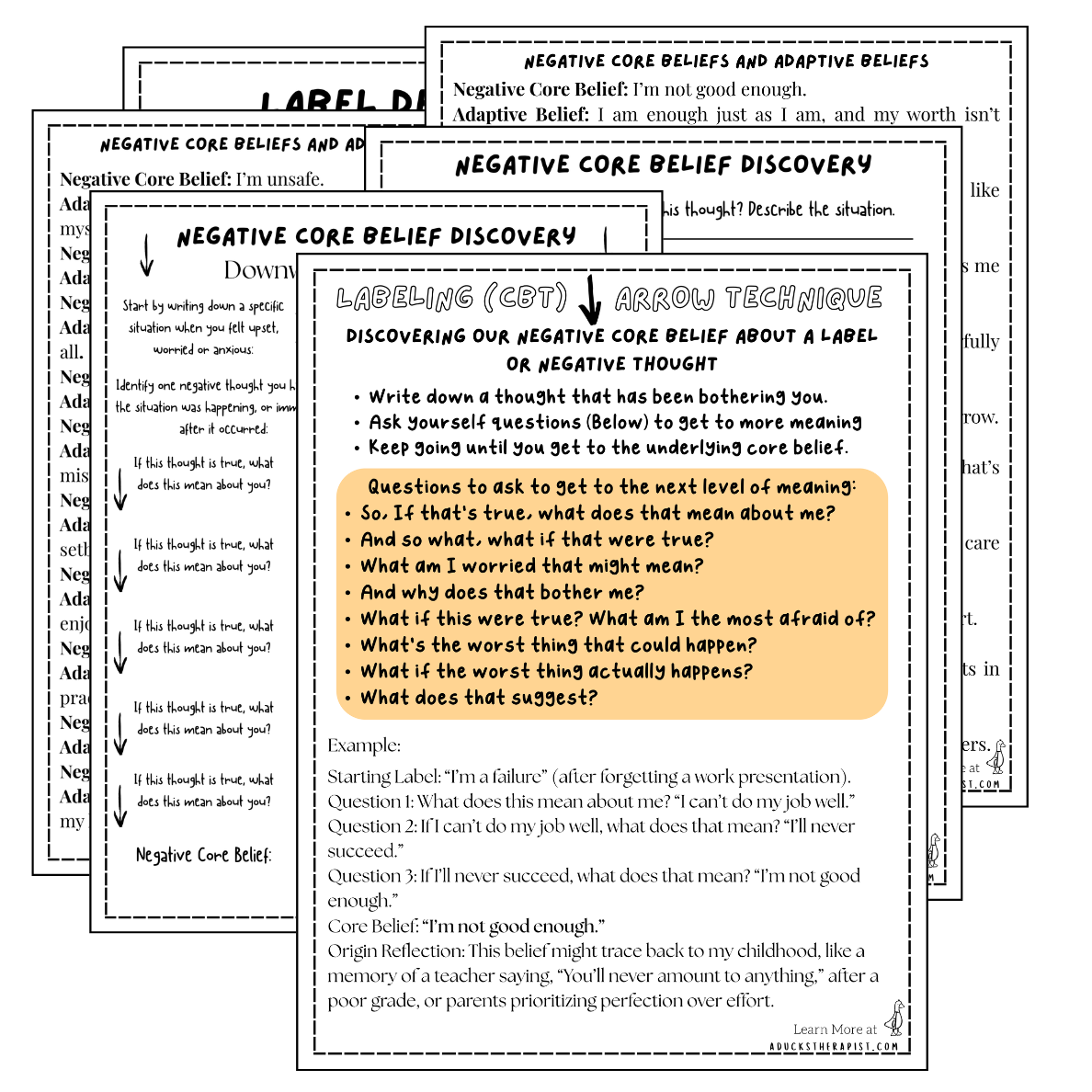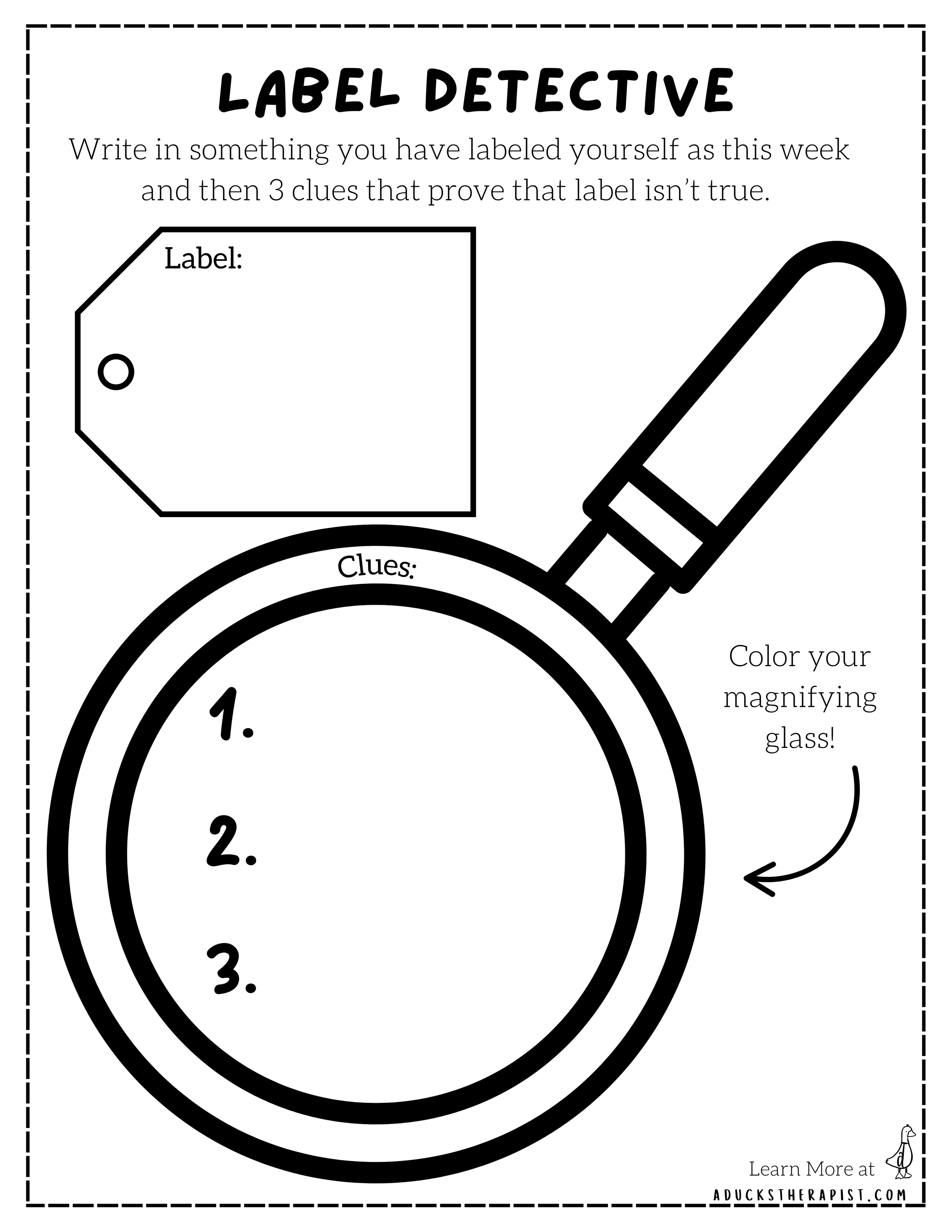Labeling + Negative Core Beliefs
This blog uses evidence-based research from CBT (Cognitive Behavioral Therapy)
Have you ever called yourself “a failure” after a single mistake or heard your child say, “I’m stupid” when they don’t understand something in school? This is labeling, a cognitive distortion where we assign oversimplified tags to ourselves or others based on a single moment. It’s a cognitive distortion in Cognitive Behavioral Therapy (CBT) that can chip away at self-esteem and fuel anxiety. Like other cognitive distortions, labeling affects kids and adults.
Labeling occurs when we define ourselves by a single action or event, overlooking the bigger picture. For adults, it might sound like “I’m a terrible parent” after losing your cool, “I’m a loser” after a work setback, or “I’m lazy” for skipping a workout. These labels oversimplify who we are, turning a single moment into a permanent identity. Labeling immediately creates the feeling of guilt and shame and makes us question our self-worth and identity. It distorts reality and is often tied to deeper negative core beliefs like “I’m not good enough,” as we judge ourselves harshly without even considering the other side. Labeling traps us in a cycle of negative self-talk, making it hard to see successes. For example, calling yourself “incompetent” after a failed project might stop you from trying again, reinforcing self-doubt. Over time, this can strain relationships or limit personal growth, as we avoid risks to subconsciously “prove” our labels true.
Help challenge labeling by examining thoughts and reframing them:
Identify the Label: Notice when you use absolute terms like “failure” or “useless.” Write it down: “I’m a bad friend for forgetting to call.” Bring awareness to the thought that you had. Sometimes when we have a negative thought about ourselves, we try to ignore it or not think about it afraid it may be true. But, oftentimes, by saying the thought back to yourself or even out loud, you can immediately recognize the intensity and lie of this label.
Question the Evidence: Ask, “What proof supports this label? What contradicts it?” (e.g., “I forgot once, but I’ve been there for my friend many times. My friend has also told me over and over again that I don’t need to feel guilty since she knows I am busy. If roles were reversed, I wouldn’t be upset if she forgot to call me.”)
Reframe the Thought: Replace the label with a balanced view: “I forgot to call, but I am still a good friend. I will send a text right now and set a plan to catch up later.”
Track Labels: Keep a journal or note in your phone and write down these labels you have about yourself. Review them to notice patterns that you have. These repeated labels may indicate patterns that can be areas for improvement. Example: If you are constantly having the thought that you are not good enough, ask yourself, “When was the first time that I had this thought ever in my life?” You may notice that you first experienced some of these thoughts when you were very young. Often, these negative beliefs about ourselves are formed when we are young and stay throughout our lives.
The Downward Arrow Technique: Uncovering Beliefs and Origins
Start with the Label: Write down a label, e.g., “I’m a failure” after forgetting a friend’s birthday.
Ask, “What Does This Mean About Me?”: Dig deeper by asking, “If I’m a failure, what does that say about me?” Answer: “I let people down.”
Keep Asking: Continue: “If I let people down, what does that mean?” Answer: “I’m not a good friend.” Then, “If I’m not a good friend, what does that mean?” Answer: “I’m unlovable.”
Reach the Core Belief: The final answer often reveals a core belief, like “I’m unlovable.”
Trace the Origin: Reflect on when this belief began. Was it a childhood memory of being scolded for a mistake? A parent’s high expectations? For example, “I felt unlovable when my dad criticized my grades, no matter how hard I tried.”
Challenge the Belief: List evidence against it, e.g., “My friends value me,” or “I show love by listening.” Reframe: “I’m worthy of love, even when I mess up.”
Questions to go deeper:
If that’s true, what does that mean about you?
What does that say about you?
And so what, what if that were true?
What are you worried that might mean?
And why does that bother you?
"What if this were true? What am I the most afraid of?
What's the worst thing that could happen?
What if the worst thing actually happens?"
What does that suggest?
FREE Download Below: Downward Arrow Technique to Uncover Our Negative Core Beliefs. See pictures for example↓
**The following photos were taken with permission to use in this blog**
How Labeling Affects Kids:
For kids, labeling shows up as harsh self-judgments, often after small setbacks. Your child might say, “I’m dumb” after a bad test score, “I’m weird” for feeling left out, or “I’m a bad kid” for getting in trouble. These labels oversimplify their complex selves, reducing them to a fixed identity. Children may also label others, such as calling a peer “annoying,” which can strain friendships. Unlike adults, kids lack the perspective to see these as temporary, making labels feel like absolute truths.
Labeling can deeply impact kids’ mental health, fueling anxiety, low self-esteem, and even depression. Negative self-labeling in kids increases anxiety, as they internalize beliefs like “I’m not good enough.” For example, a child who labels themselves “stupid” might avoid schoolwork, fearing failure, which spirals into stress and withdrawal. Labels also affect social skills—calling oneself “unlikeable” can make kids shy away from friends, reinforcing feelings of loneliness. Over time, these patterns hinder confidence and resilience.
Questioning Thoughts to Uncover Beliefs
Spot the Label: Help your child notice labels like “I’m stupid.” Ask, “What did you just say about yourself?” Comment on the thought “Ooo, that is not very nice. Would you say something like this to your best friend? No? What would you tell them if they told you that they are stupid?”
Check the Facts: Ask, “What’s the evidence for this thought? When mom makes a mistake, does that mean she’s stupid? Tell me about a time you figured out something hard and felt proud of yourself.”
Try a New Thought: Guide them to reframe: “I’m learning, and that’s okay” instead of “I’m stupid.”
Dig Deeper: Ask, “What does ‘stupid’ mean about you?” to uncover deeper beliefs like “I’m not good enough.” Sometimes these are the deeper beliefs that accompany the “I’m stupid” thoughts. Counter with examples of their strengths, like solving a puzzle or being kind and saying, “I am good enough the way I am.”
Practical Steps to Help Kids
Listen Without Judgment: When your child labels themselves (e.g., “I’m a loser”), validate their feelings: “It sounds tough to feel that way. Want to talk about it?
Model Balanced Thinking: Share your own reframes: “I burnt the chicken, but I’m still a good cook.” This shows kids how to soften labels.
Play the “Label Swap” Game: When your child uses a label, ask, “What’s a kinder word?” (e.g., “learning” instead of “dumb”)
Highlight Strengths Daily: Point out one thing they did well (e.g., “You were so brave trying that bike trick!”) to build positive self-beliefs.
All content on A Duck’s Therapist is created and tested by a Licensed Professional Counselor
Citations:
Fennell, M. J. V., & Jenkins, H. (2017). Core beliefs and psychological distress: A review of the evidence. Cognitive Therapy and Research
Shapiro, S. J., & Hofmann, S. G. (2018). Cognitive-behavioral therapy for anxiety disorders in youth: A meta-analysis. Journal of Clinical Child & Adolescent Psychology
Beck, A. T. (1979). Cognitive therapy and the emotional disorders.
Wesselmann, E. D., & Graziano, W. G. (2019). Self-labeling and internalizing symptoms in children: A longitudinal study. *Child Psychiatry & Human Development,







